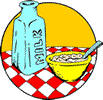
Grades K-2, 3-5
Happy EconEdMonth! Celebrate economics all month long by visiting EconEdMonth.org

Don't have an account yet? Sign up for free
Don't have an account yet? Sign up for free


In this lesson students working in cooperative groups will: 1.Discuss food items they consume for breakfast. 2.Investigate elements of foreign culture, particularly food. 3.Use map skills to locate selected foreign nations. 4.Increase their knowledge of the these definitions: Economic wants are things people would like to have. Goods and services are provided to fulfill these wants. Those who create the goods and provide the services are producers. Those who use them are consumers. Consumers found in different parts of the world may have differing wants. Foods for satisfying hunger are a common economic want. Foods can vary greatly from one part of the world to another
In this lesson students working in cooperative groups will:
Helpful prerequisites:
It would be helpful if these vocabulary words and their definitions were written on chart paper to be hung around the room. Students can refer to them as needed and charts can be used again in a later lesson.

Review key vocabulary words, checking for understanding:
Review might include samples from the paper squares or any the students can verbalize. Select grade-appropriate words to add to students’ spelling lists.
A variety of activities are available for the teacher to assign to capable learners or for interested individuals or groups to choose from.
(For Linguistic learners) Student narratives about experiences eating ethnic foods. Reading story books from the library telling of ethnic foods. Creating a display of ethnic cookbooks.
(For Visual, Spatial learners) Sketches on paper plates or magazine cut-out collages to represent foods featured in the lesson.
(For Bodily/Kinesthetic learners) Read this for more research. Allow extra credit to students who can share additional information in a creative, unusual way. Use this site to complete some of the activities provided there. Or choose a nation not listed on the site and create an illustrated report similar to those provided.
(For Interpersonal/Intrapersonal learners) Groups or individuals may wish to visit the https://www.campbellsoupcompany.com/about-campbell/our-businesses/ web site. It shows a world map and commercials, products, and information about this company and its operations in different parts of hte world. “Fun Facts” trivia found there could be used by students to investigate the concepts of markets and prices.

Grades K-2, 3-5

Grades 3-5, 6-8

Grades K-2, 3-5

Grades K-2
